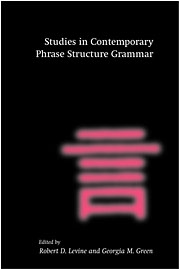Book contents
- Frontmatter
- Contents
- Introduction
- 1 The lexical integrity of Japanese causatives
- 2 A syntax and semantics for purposive adjuncts in HPSG
- 3 On lexicalist treatments of Japanese causatives
- 4 “Modal flip” and partial verb phrase fronting in German
- 5 A lexical comment on a syntactic topic
- 6 Agreement and the syntax–morphology interface in HPSG
- 7 Partial VP and split NP topicalization in German: an HPSG analysis
- Index
3 - On lexicalist treatments of Japanese causatives
Published online by Cambridge University Press: 16 December 2009
- Frontmatter
- Contents
- Introduction
- 1 The lexical integrity of Japanese causatives
- 2 A syntax and semantics for purposive adjuncts in HPSG
- 3 On lexicalist treatments of Japanese causatives
- 4 “Modal flip” and partial verb phrase fronting in German
- 5 A lexical comment on a syntactic topic
- 6 Agreement and the syntax–morphology interface in HPSG
- 7 Partial VP and split NP topicalization in German: an HPSG analysis
- Index
Summary
Introduction
The causative construction, along with other “complex predicate” constructions, has been analyzed in one of two ways: an analysis in which the causative sase is treated as a verb that is a sister of the verb phrase headed by the verb, and an analysis that supposes that the causative is morphologically a suffix and that the sequence consisting of a verb and the causative suffix is equivalent to a lexical verb. While many pieces of the syntactic and semantic evidence seem to favor the former analysis, morphological and phonological properties clearly suggest that a verb stem followed by the causative is indeed a word. In addition, interaction with some lexical processes seems to be best explained by the latter approach.
In classical transformational analyses, this apparent dilemma was solved by postulating a biclausal structure in a structure different from the surface one, namely, the deep structure; the head verb of the embedded clause is subsequently raised to amalgamate with the causative sase by the time the surface structure is obtained (cf. Shibatani 1973). Essentially the same kind of analysis is assumed in more recent transformational analyses, in which the operation of head movement creates the morphological and phonological integrity in PF (phonetic form), while in LF (logical form) the biclausal structure is essentially retained.
In the (strict) lexicalist approach, in which no reorganization transformation is available, the above dilemma may lead to a major problem.
- Type
- Chapter
- Information
- Studies in Contemporary Phrase Structure Grammar , pp. 119 - 160Publisher: Cambridge University PressPrint publication year: 2000
- 1
- Cited by



